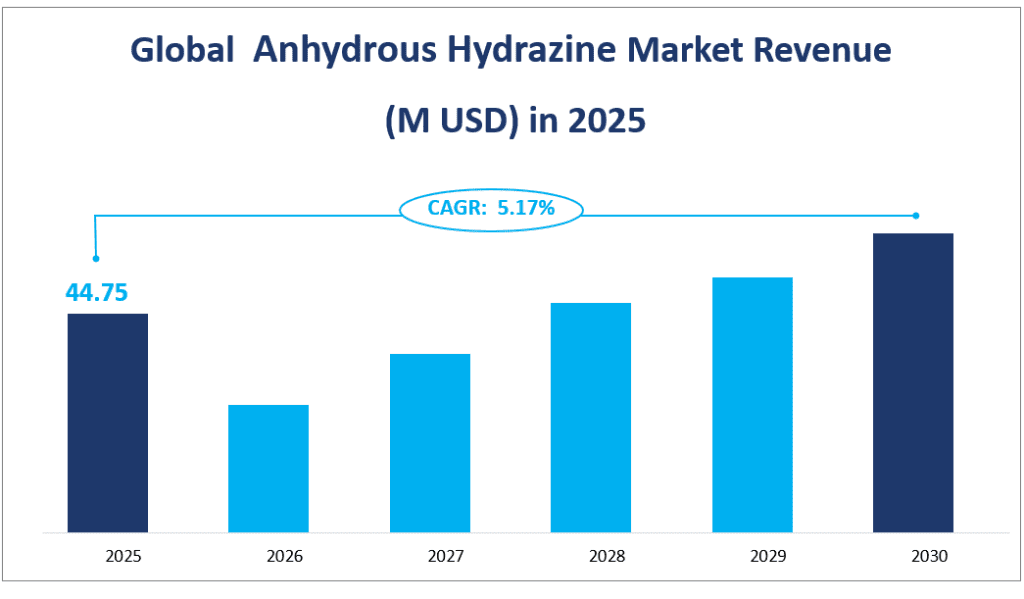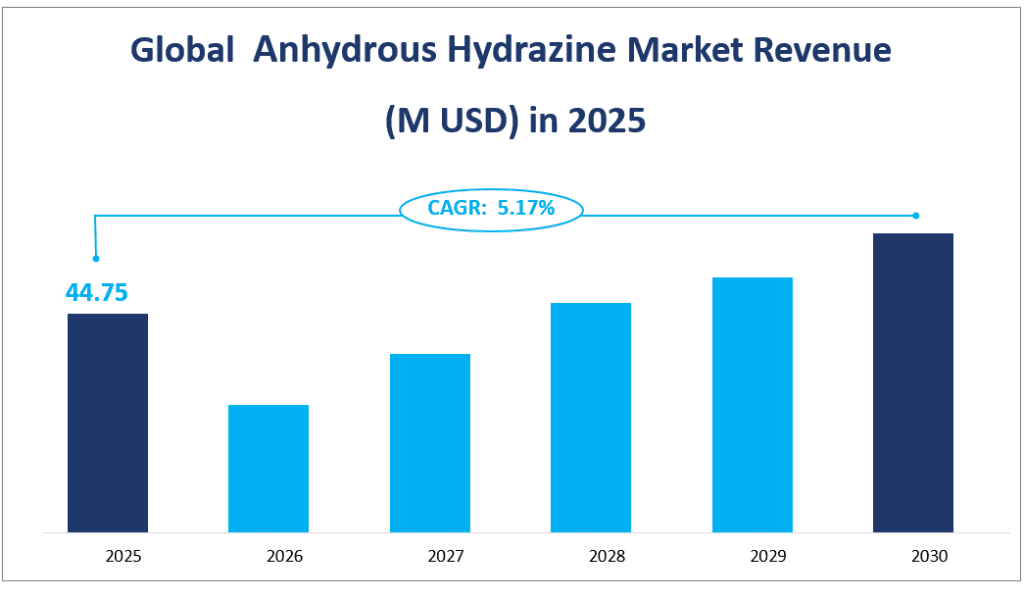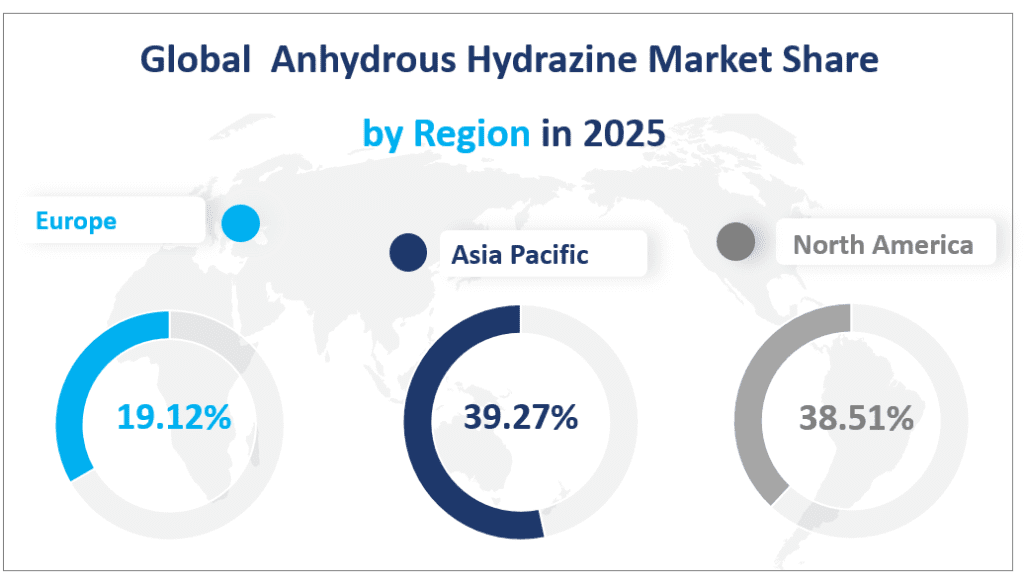1. Global Anhydrous Hydrazine Market Summary
By 2025, the global Anhydrous Hydrazine market is projected to reach a value of approximately $44.75 million with a CAGR of 5.17% from 2025 to 2030.
Anhydrous Hydrazine (N₂H₄) is a clear, colorless, hygroscopic liquid with a distinct ammonia-like odor. It is a highly polar solvent, miscible with other polar solvents but immiscible with non-polar solvents. This chemical is primarily used as a rocket propellant due to its high heat of combustion and endothermic heat of formation. Additionally, it serves as an essential intermediate in the pharmaceutical industry, used in the production of drugs such as isoniazid, pyridazine, and phenelzine. Anhydrous Hydrazine is also utilized in various industrial applications, including as a deoxidizer for boiler water and as a raw material in the synthesis of fine chemicals.
Global Anhydrous Hydrazine Market Revenue (M USD) in 2025


2. Driving Factors of Anhydrous Hydrazine Market Growth
The growth of the Anhydrous Hydrazine market is primarily driven by increasing demand from key regions and applications. The United States, a major player in the aerospace industry, continues to invest heavily in space exploration and satellite launches, driving the need for rocket propellants. Similarly, the Asia-Pacific region, led by China, Japan, and India, is experiencing rapid economic growth and technological advancements in aerospace and defense, further boosting demand for Anhydrous Hydrazine.
Another significant driver is the growing commercialization of space activities. Companies like SpaceX and Blue Origin are increasing the frequency of satellite launches, contributing to the demand for rocket propellants. Additionally, the pharmaceutical industry’s reliance on Anhydrous Hydrazine as an intermediate for producing essential drugs ensures a stable demand from this sector.
3. Limiting Factors of Anhydrous Hydrazine Market Growth
Despite its growing demand, the Anhydrous Hydrazine market faces several challenges. One of the primary concerns is the environmental impact of the chemical. Anhydrous Hydrazine is toxic and can cause significant environmental pollution if not handled properly. This has led to stricter regulations and increased scrutiny from environmental agencies, potentially limiting its use in certain applications.
Another limiting factor is the threat of substitute products. With the increasing focus on green technologies, there is a growing demand for non-toxic and environmentally friendly alternatives to traditional rocket propellants. Electric propulsion systems, for example, offer higher efficiency and lower environmental impact, posing a significant challenge to the traditional Anhydrous Hydrazine-based systems.
4. Global Anhydrous Hydrazine Market Segment
Product Types
Monopropellant Grade Anhydrous Hydrazine is the dominant product type, primarily used in rocket propulsion systems due to its high energy density and combustion efficiency. By 2025, the market consumption of Monopropellant Grade is projected to reach 69,193 KG. This type has consistently held the largest market share, accounting for 84.08% of the total market in 2025. The growth rate of Monopropellant Grade is driven by the increasing demand from the aerospace industry, particularly in satellite launches and space exploration missions. The United States and the Asia-Pacific region, with their robust aerospace sectors, are key drivers of this demand.
Standard Grade Anhydrous Hydrazine is used in a broader range of applications, including industrial processes and pharmaceutical manufacturing. By 2025, the market consumption of Standard Grade is expected to reach 13,098 KG, representing 15.92% of the total market. While its market share is smaller compared to Monopropellant Grade, Standard Grade is experiencing a steady growth rate, driven by increasing industrial activities and pharmaceutical production.
Monopropellant Grade Anhydrous Hydrazine holds the largest market share and is projected to maintain its dominance through 2025. However, Standard Grade is also growing at a notable rate, driven by its versatile applications in industrial and pharmaceutical sectors. The fastest growth rate is observed in the Standard Grade segment, primarily due to its expanding use in emerging economies and the increasing demand for high-purity chemicals in pharmaceutical production.
Analysis of Applications
Rocket Propellant is the largest application segment for Anhydrous Hydrazine, driven by the aerospace industry’s reliance on this chemical for propulsion systems. By 2025, the market consumption for Rocket Propellant is projected to reach 64,473 KG, accounting for 78.35% of the total market. The growth rate of this application is influenced by increasing space exploration activities, satellite launches, and the commercialization of space missions. The United States and the Asia-Pacific region are key contributors to this demand, with companies like SpaceX and Blue Origin driving innovation and demand in the sector.
Industrial applications of Anhydrous Hydrazine include its use as a deoxidizer, boiler water treatment agent, and raw material in the synthesis of fine chemicals. By 2025, the market consumption for Industrial Applications is expected to reach 10,306 KG, representing 12.52% of the total market. The growth rate in this segment is driven by increasing industrial activities, particularly in emerging economies where infrastructure development and chemical manufacturing are on the rise. The Asia-Pacific region, led by China and India, is a significant driver of this demand.
Rocket Propellant remains the largest application segment for Anhydrous Hydrazine, driven by the aerospace industry’s continuous demand for high-performance fuels. However, Industrial Applications and Other Applications are also experiencing significant growth rates, driven by expanding industrial activities and the increasing demand for high-purity chemicals. The fastest growth rate is observed in the Industrial Applications segment, primarily due to its versatile use in emerging economies and the increasing demand for deoxidizers and boiler water treatments.
Market Consumption and Share by Segment
| Market Consumption (KG) in 2025 | Market Share in 2025 | ||
| By Type | Monopropellant Grade | 69193 | 84.08% |
| Standard Grade | 13098 | 15.92% | |
| By Application | Rocket Propellant | 64473 | 78.35% |
| Industrial | 10306 | 12.52% | |
| Others | 7572 | 9.20% |
5. Regional Anhydrous Hydrazine Market
North America is anticipated to remain the largest regional market for Anhydrous Hydrazine by value in 2025. The region is expected to achieve a market value of $17.23 million, accounting for 38.51% of the global market. The United States, in particular, drives this market due to its robust aerospace and defense industries, which heavily rely on rocket propellants. Companies like SpaceX and NASA continue to invest in space exploration, further boosting the demand for Anhydrous Hydrazine. Additionally, the presence of major chemical manufacturers and a well-developed industrial base supports the market’s stability and growth.
The Asia-Pacific region is projected to be the fastest-growing region in the Anhydrous Hydrazine market. By 2025, the market value in this region is expected to reach $17.58 million, representing 39.27% of the global market. The rapid economic growth in countries like China, Japan, and India is driving the demand for Anhydrous Hydrazine. China, in particular, is emerging as a significant player in the aerospace sector, with increasing investments in satellite launches and space exploration. Additionally, the growing pharmaceutical industry in the region, especially in India, is creating a stable demand for Anhydrous Hydrazine as a key intermediate in drug production.
Europe is another major market for Anhydrous Hydrazine, with a projected value of $8.56 million by 2025, accounting for 19.12% of the global market. The region’s aerospace and defense industries, particularly in Germany and Russia, drive the demand for rocket propellants. Additionally, the presence of advanced manufacturing capabilities and a focus on technological innovation support the market’s growth. However, regulatory challenges and environmental concerns may limit the market’s expansion compared to the Asia-Pacific region.
North America is expected to remain the largest regional market for Anhydrous Hydrazine by value in 2025, driven by its robust aerospace and defense industries. However, the Asia-Pacific region is poised to be the fastest-growing market, fueled by rapid economic growth, increasing investments in space exploration, and a burgeoning pharmaceutical industry. Companies operating in these regions must focus on leveraging technological advancements and addressing regulatory challenges to capitalize on the market’s potential.
Global Anhydrous Hydrazine Market Share by Region in 2025


6. Top 3 Companies in the Anhydrous Hydrazine Market
Lonza Specialty Ingredients (Arxada)
Company Introduction and Business Overview:
Lonza Specialty Ingredients (Arxada) is a leading global manufacturer and supplier of specialty chemicals. Established in 1897, the company has a strong presence in the water treatment market and is known for its high-quality products. Through its acquisition of Arch Chemicals in 2011, Lonza became the world’s largest supplier of swimming pool and spa disinfectants. The company operates globally, with manufacturing plants primarily located in the United States.
Products Offered:
Lonza offers a wide range of Anhydrous Hydrazine products, including Monopropellant Grade and Standard Grade. These products are used in rocket propulsion, industrial processes, and pharmaceutical manufacturing. The company’s focus on high-purity grades ensures that its products meet the stringent requirements of the aerospace and pharmaceutical industries.
Company Introduction and Business Overview:
Ghc Gerling Holz & Co, established in 1904, is a leading European gas supplier based in Hamburg, Germany. The company specializes in providing high-quality gases, specialty chemicals, and related equipment. Ghc Gerling Holz & Co is known for its technical solutions and ability to meet complex regulatory requirements globally.
Products Offered:
The company offers a range of Anhydrous Hydrazine products tailored for rocket propulsion and satellite fuel applications. Its products are renowned for their precision and reliability, making them a preferred choice for international space stations and aerospace companies.
Company Introduction and Business Overview:
Mil-Spec Industries Corp., established in 1992, is a global manufacturer and supplier of specialty chemicals, energetic materials, pyrotechnics, ordnance, and aerospace components. The company operates primarily in the United States and serves the Defense, Aerospace, and Commercial industries. Mil-Spec Industries is known for its high-quality products and innovative solutions.
Products Offered:
Mil-Spec Industries offers a variety of Anhydrous Hydrazine products, including Technical Grade for industrial applications. The company’s focus on quality and innovation ensures that its products meet the demanding requirements of the aerospace and defense sectors.
Major Players
| Company Name | Plants Distribution | Sales Region |
| Lonza Specialty Ingredients (Arxada) | USA | Worldwide |
| Ghc Gerling Holz & Co | Germany | Worldwide |
| Mil-Spec Industries | USA | Worldwide |
| Mitani Sangyo | Japan | Mainly in Asia Pacific |
1 Scope of the Report
1.1 Market Introduction
1.2 Research Objectives
1.3 Years Considered
1.4 Market Research Methodology
1.5 Economic Indicators
1.6 Currency Considered
1.7 Specifications of High Purity Grade Anhydrous Hydrazine
1.8 Global High Purity Grade Anhydrous Hydrazine Consumption 2017-2027
1.9 Global High Purity Grade Anhydrous Hydrazine Production by Players (2017-2022)
2 Executive Summary
2.1 World Market Overview
2.1.1 Global Anhydrous Hydrazine Consumption 2017-2027
2.1.2 Anhydrous Hydrazine Consumption CAGR by Region
2.2 Anhydrous Hydrazine Segment by Type
2.2.1 Monopropellant Grade
2.2.2 Standard Grade
2.3 Anhydrous Hydrazine Consumption by Type
2.3.1 Global Anhydrous Hydrazine Consumption Market Share by Type (2017-2022)
2.3.2 Global Anhydrous Hydrazine Value and Market Share by Type (2017-2022)
2.3.3 Global Anhydrous Hydrazine Sale Price by Type (2017-2022)
2.4 Anhydrous Hydrazine Segment by Application
2.4.1 Rocket Propellant
2.4.2 Industrial
2.5 Anhydrous Hydrazine Consumption by Application
2.5.1 Global Anhydrous Hydrazine Consumption Market Share by Application (2017-2022)
2.5.2 Global Anhydrous Hydrazine Value and Market Share by Application (2017-2022)
2.5.3 Global Anhydrous Hydrazine Price by Application (2017-2022)
3 Global Anhydrous Hydrazine by Players
3.1 Global Anhydrous Hydrazine Production Market Share by Players
3.1.1 Global Anhydrous Hydrazine Production by Players (2017-2022)
3.1.2 Global Anhydrous Hydrazine Production Market Share by Players (2017-2022)
3.2 Global Anhydrous Hydrazine Value Market Share by Players
3.2.1 Global Anhydrous Hydrazine Value by Players (2017-2022)
3.2.2 Global Anhydrous Hydrazine Value Market Share by Players (2017-2022)
3.3 Global Anhydrous Hydrazine Sale Price by Players
3.4 Global Anhydrous Hydrazine Manufacturing Base Distribution, Production Area, Type Types by Players
3.4.1 Global Anhydrous Hydrazine Manufacturing Base Distribution and Production Area by Players
3.4.2 Players Anhydrous Hydrazine Types Offered
3.5 Market Concentration Rate Analysis
3.5.1 Competition Landscape Analysis
3.6 New Types and Potential Entrants
3.7 Mergers & Acquisitions, Expansion
4 Anhydrous Hydrazine by Regions
4.1 Anhydrous Hydrazine by Regions
4.1.1 Global Anhydrous Hydrazine Consumption by Regions
4.1.2 Global Anhydrous Hydrazine Value by Regions
4.2 North America Anhydrous Hydrazine Consumption Growth
4.3 APAC Anhydrous Hydrazine Consumption Growth
4.4 Europe Anhydrous Hydrazine Consumption Growth
4.5 Middle East & Africa Anhydrous Hydrazine Consumption Growth
5 North America
5.1 North America Anhydrous Hydrazine Consumption by Countries
5.1.1 North America Anhydrous Hydrazine Consumption by Countries (2017-2022)
5.1.2 North America Anhydrous Hydrazine Value by Countries (2017-2022)
5.2 North America Anhydrous Hydrazine Consumption by Types
5.3 North America Anhydrous Hydrazine Consumption by Applications
5.4 United States
5.5 Canada
5.6 Mexico
6 APAC
6.1 APAC Anhydrous Hydrazine Consumption by Countries
6.1.1 APAC Anhydrous Hydrazine Consumption by Countries
6.1.2 APAC Anhydrous Hydrazine Value by Countries
6.2 APAC Anhydrous Hydrazine Consumption by Types
6.3 APAC Anhydrous Hydrazine Consumption by Applications
6.4 China
6.5 Japan
6.6 South Korea
6.7 India
7 Europe
7.1 Europe Anhydrous Hydrazine Consumption by Countries
7.1.1 Europe Anhydrous Hydrazine Consumption by Countries
7.1.2 Europe Anhydrous Hydrazine Value by Countries
7.2 Europe Anhydrous Hydrazine Consumption by Types
7.3 Europe Anhydrous Hydrazine Consumption by Applications
7.4 Germany
7.5 France
7.6 UK
7.7 Russia
8 Market Drivers, Challenges and Trends
8.1 Market Drivers and Impact
8.1.1 Growing Demand from Key Regions
8.1.2 Growing Demand from Key Applications and Potential Industries
8.2 Market Challenges and Impact
8.3 Market Trends
9 Marketing, Distributors and Customer
9.1 Sales Channel
9.1.1 Direct Channel
9.1.2 Indirect Channel
9.2 Anhydrous Hydrazine Distributors
9.3 Anhydrous Hydrazine Customer
10 Global Anhydrous Hydrazine Market Forecast
10.1 Global Anhydrous Hydrazine Consumption Forecast
10.2 Global Anhydrous Hydrazine Consumption Forecast by Regions
10.2.1 Global Anhydrous Hydrazine Forecast by Regions (2022-2027)
10.2.2 Global Anhydrous Hydrazine Value Forecast by Regions 2022-2027
10.3 North America Forecast by Countries
10.3.1 United States Market Forecast
10.3.2 Canada Market Forecast
10.3.3 Mexico Market Forecast
10.4 APAC Forecast by Countries
10.4.1 China Market Forecast
10.4.2 Japan Market Forecast
10.4.3 South Korea Market Forecast
10.4.4 India Market Forecast
10.5 Europe Forecast by Countries
10.5.1 Germany Market Forecast
10.5.2 France Market Forecast
10.5.3 UK Market Forecast
10.5.4 Russia Market Forecast
10.6 Global Anhydrous Hydrazine Market Forecast by Type
10.7 Global Anhydrous Hydrazine Market Forecast by Application
11 Key Players Analysis
11.1 Competitive Profile
11.2 Lonza Specialty Ingredients (Arxada)
11.2.1 Company Profiles
11.2.2 Anhydrous Hydrazine Type Introduction
11.2.3 Lonza Specialty Ingredients (Arxada) Sales, Value, Price, Gross Margin 2017-2022
11.3 Ghc Gerling Holz & Co
11.3.1 Company Profiles
11.3.2 Anhydrous Hydrazine Type Introduction
11.3.3 Ghc Gerling Holz & Co Sales, Value, Price, Gross Margin 2017-2022
11.4 Mil-Spec Industries
11.4.1 Company Profiles
11.4.2 Anhydrous Hydrazine Type Introduction
11.4.3 Mil-Spec Industries Sales, Value, Price, Gross Margin 2017-2022
11.5 Mitani Sangyo
11.5.1 Company Profiles
11.5.2 Anhydrous Hydrazine Type Introduction
11.5.3 Mitani Sangyo Sales, Value, Price, Gross Margin 2017-2022
12 Research Findings and Conclusion
13 Appendix
13.1 Methodology
13.2 Research Data Source
